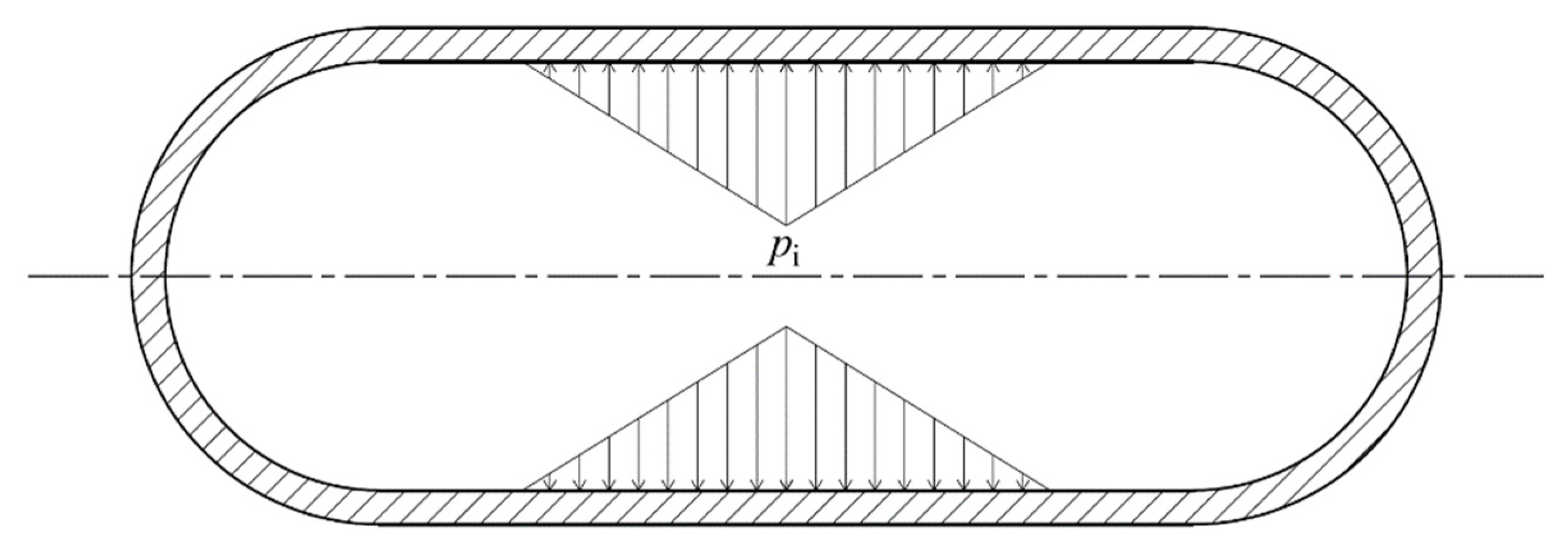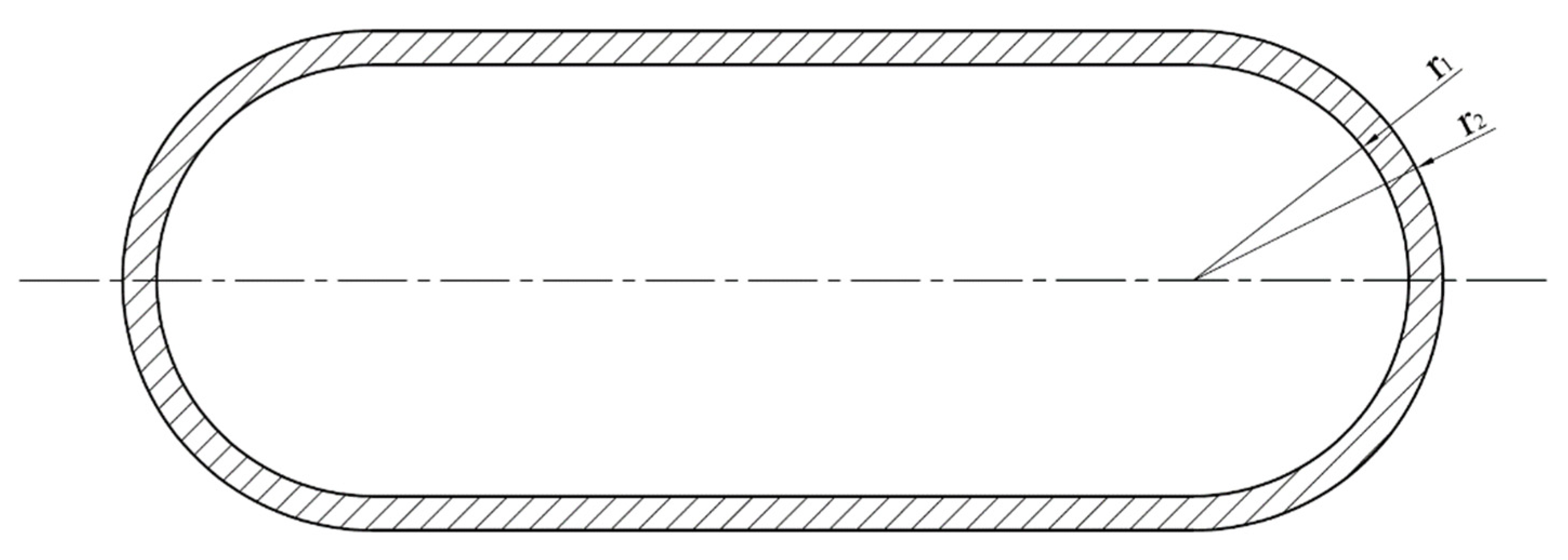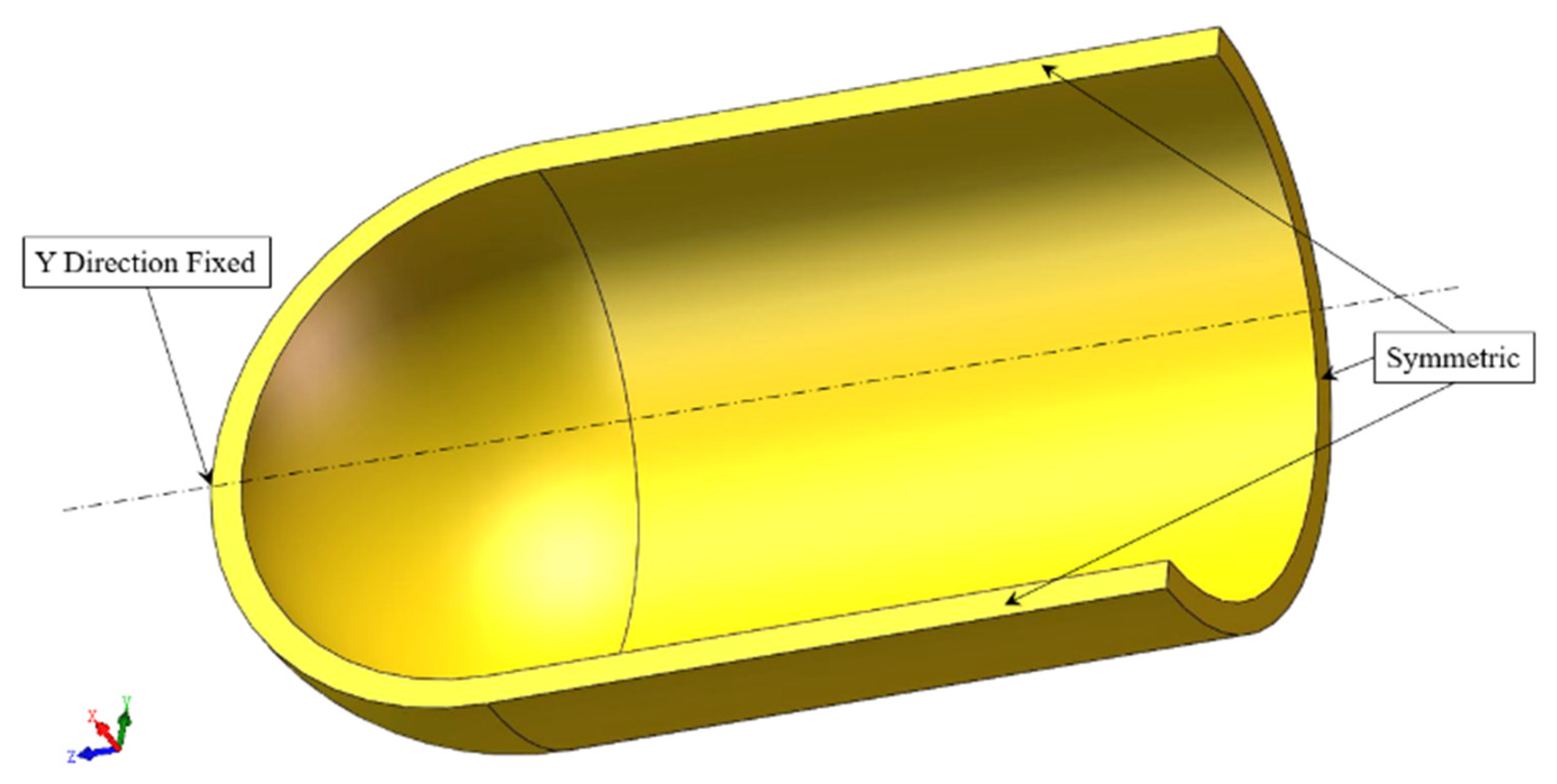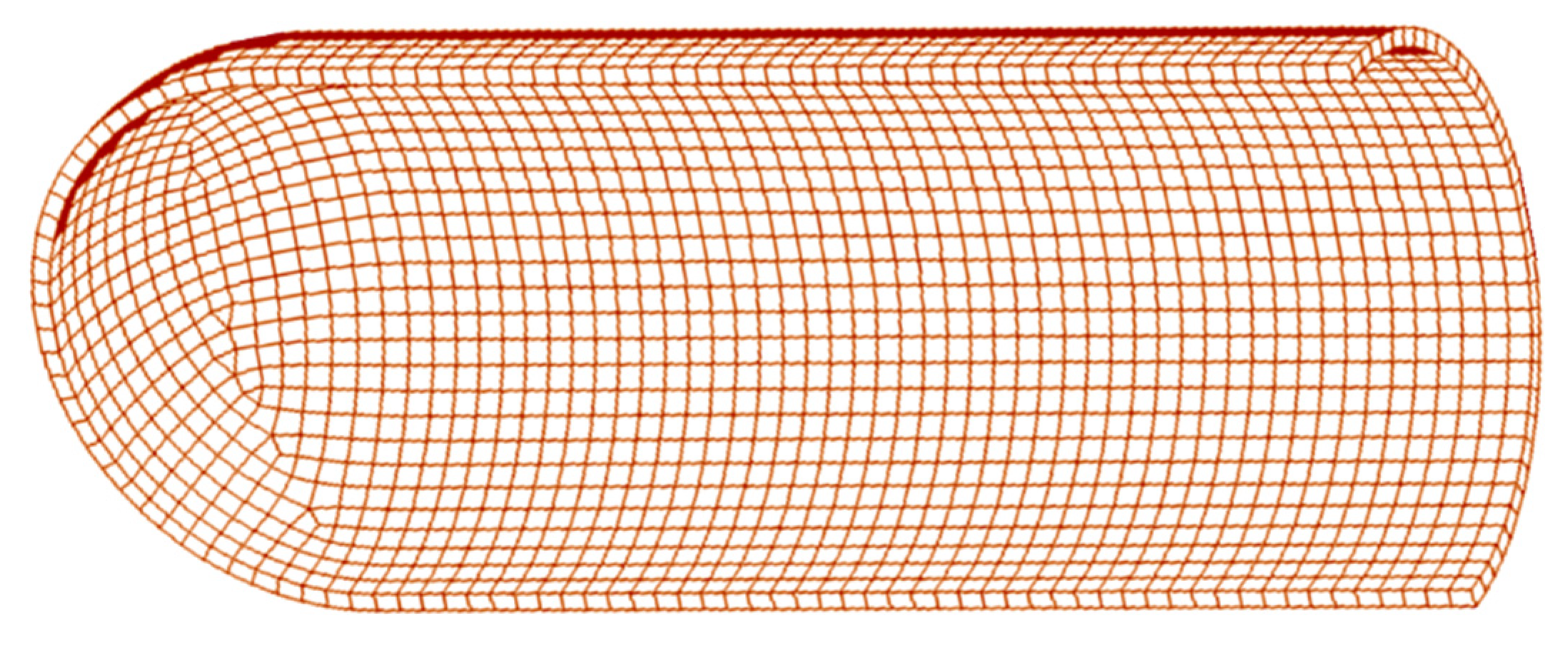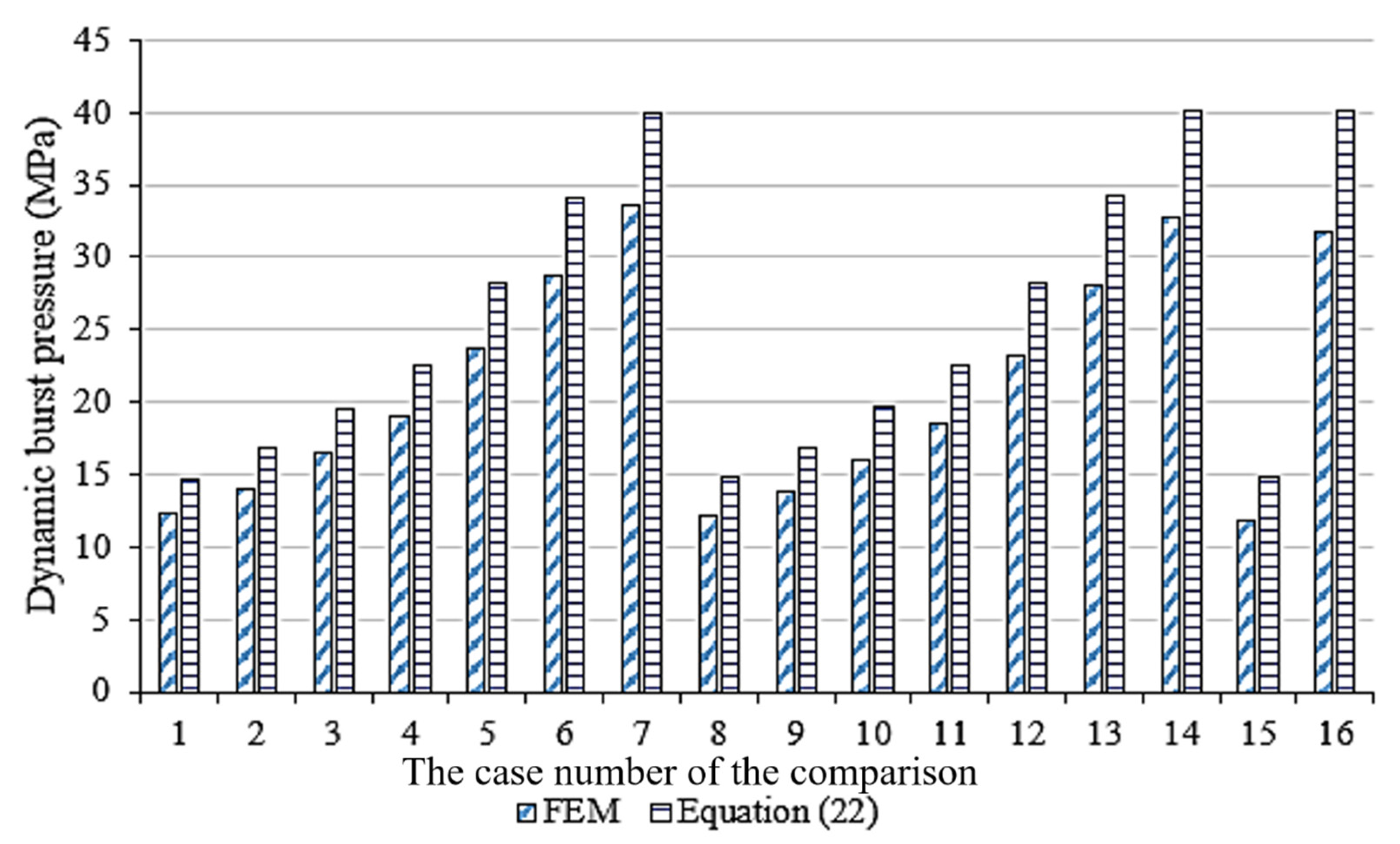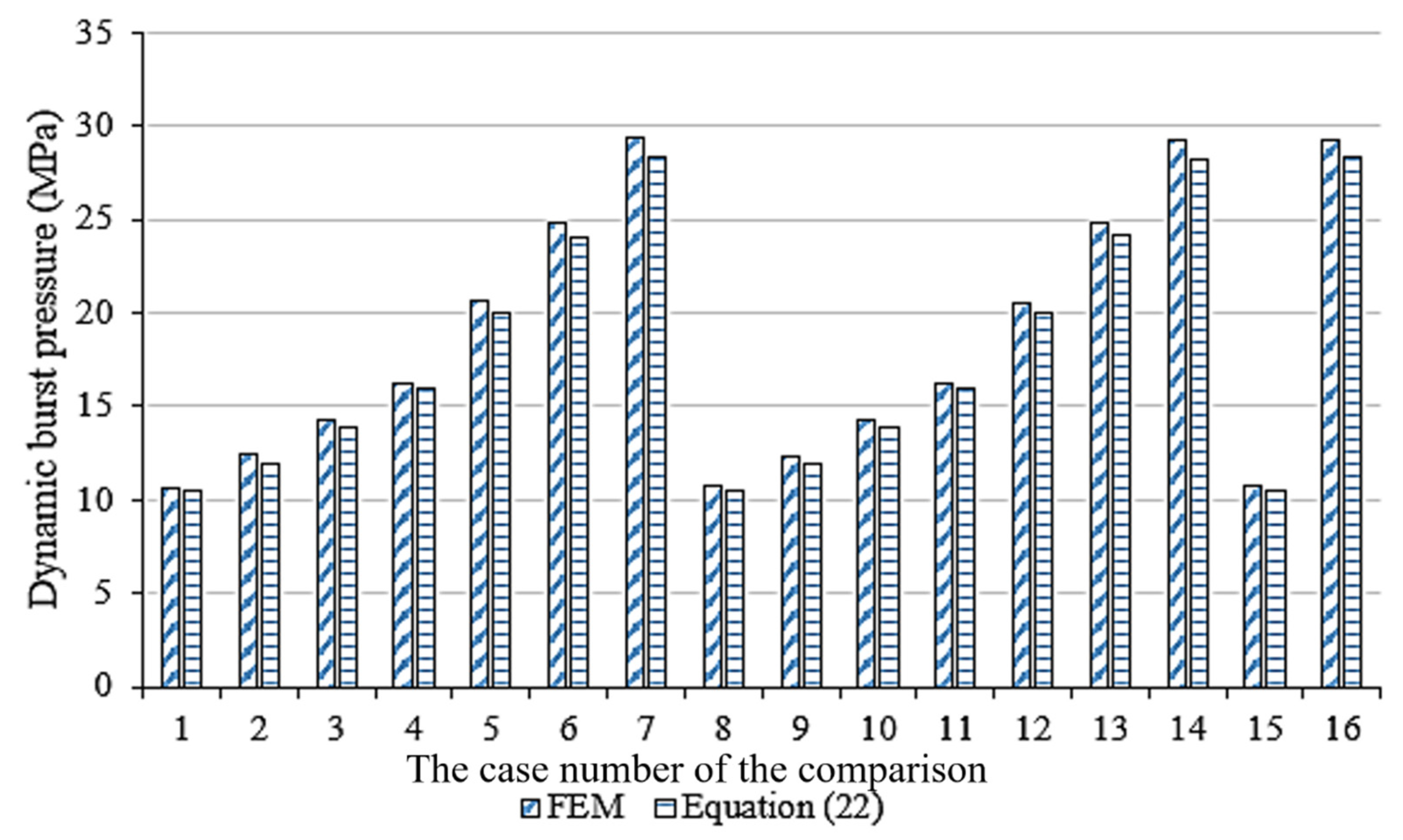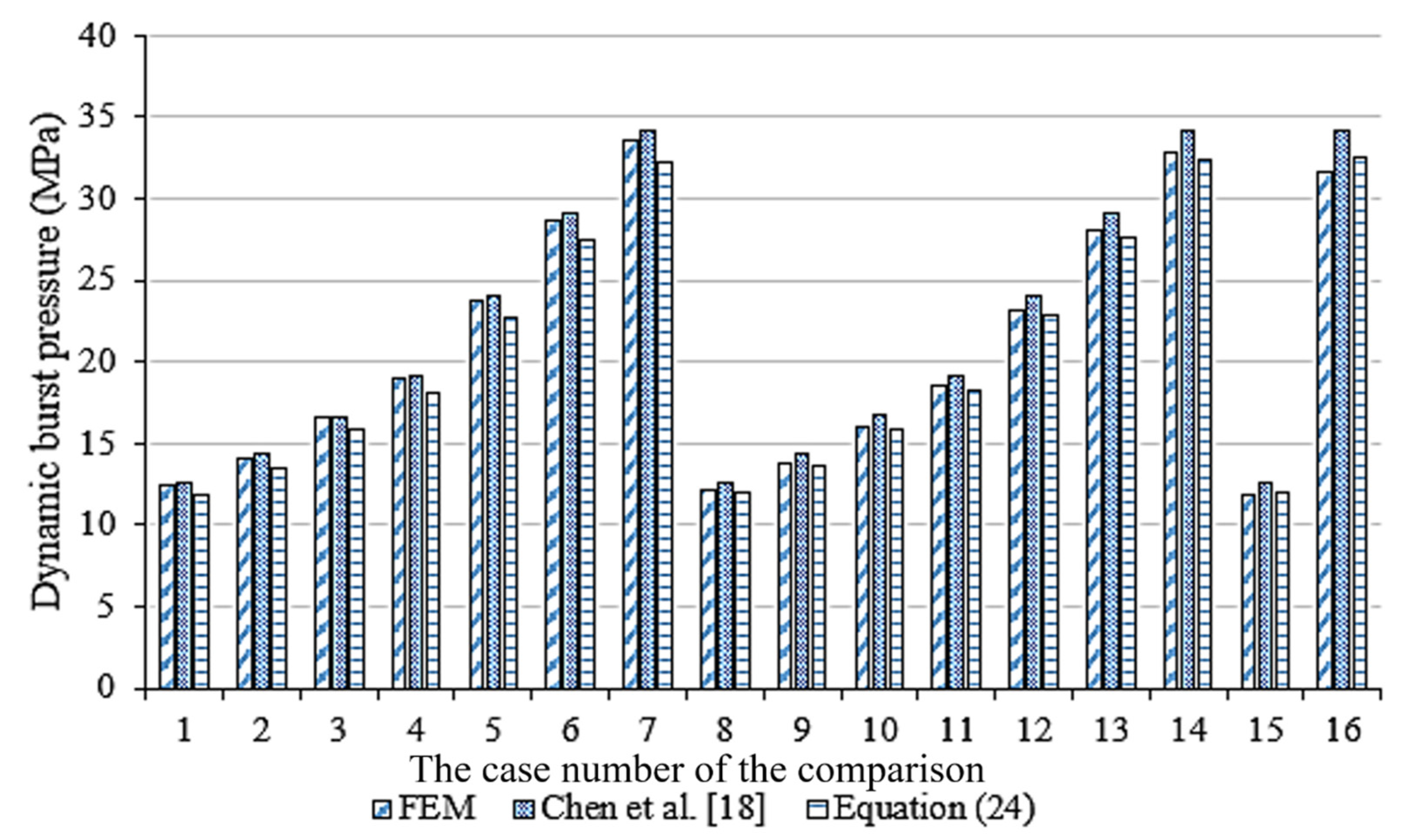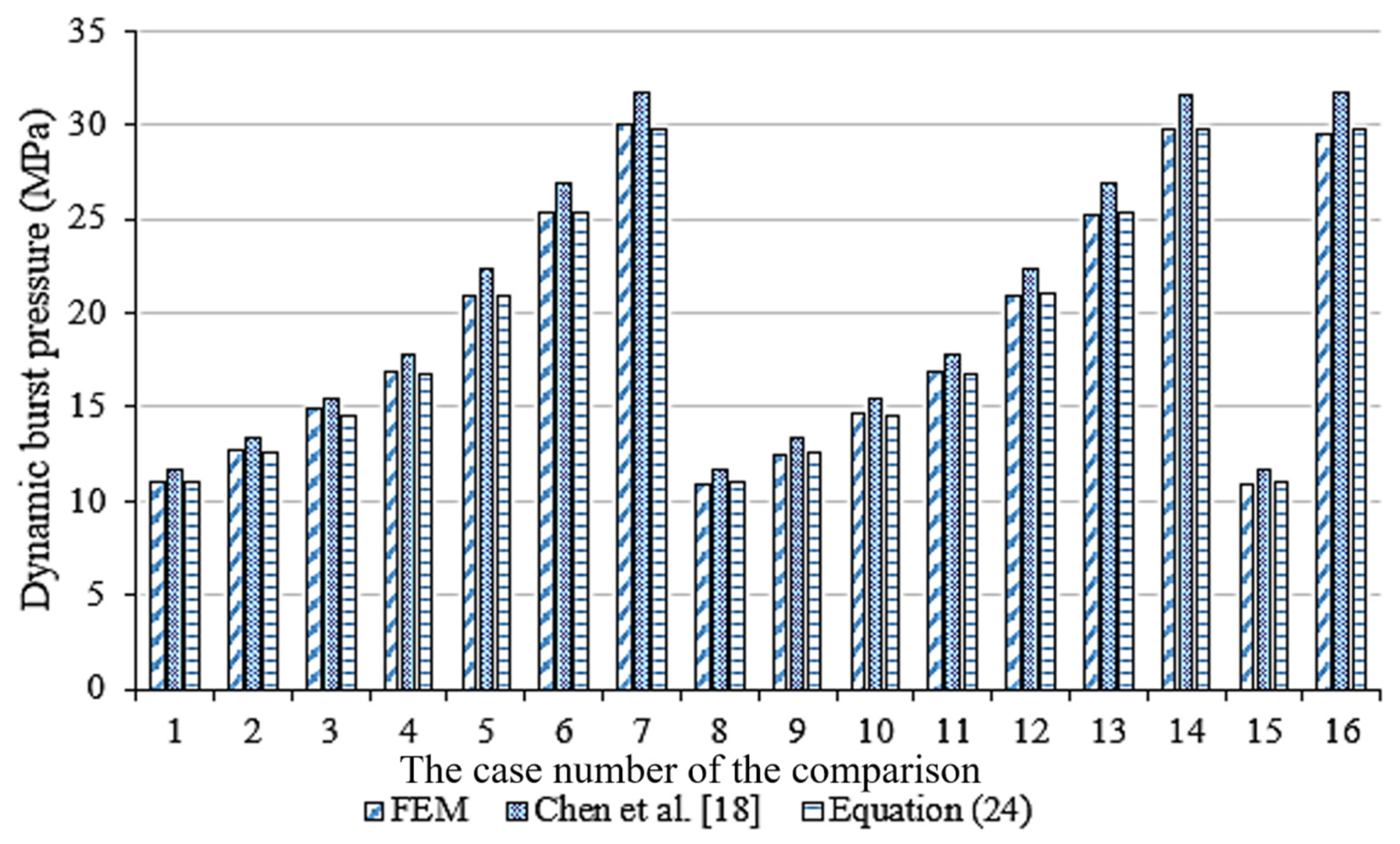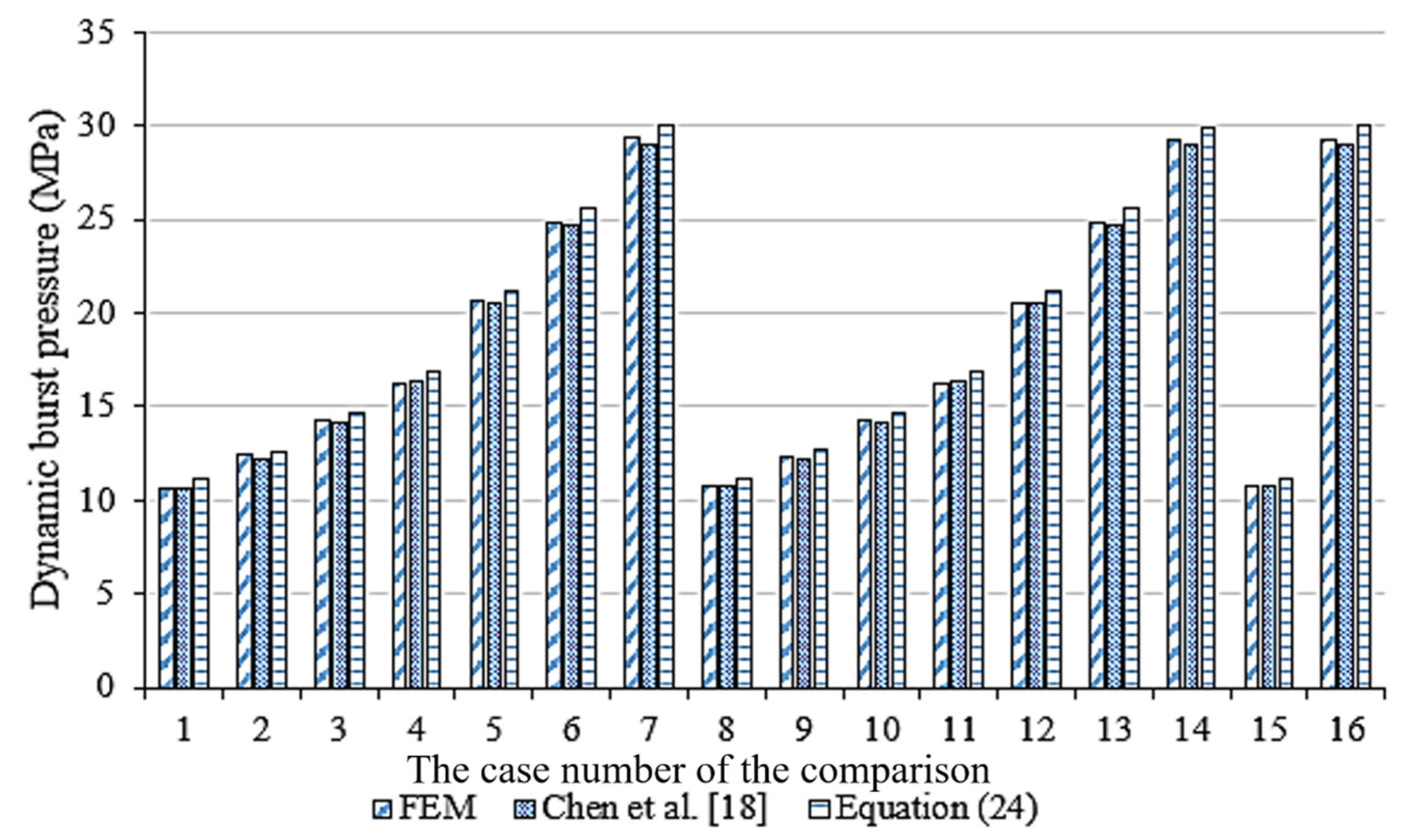1. Introduction
Cylindrical shells are special pressure vessels that are widely used in offshore and sub-marine structures, among others. In offshore applications, the cylindrical shell structures are utilized to transport oil and gas [
1]. In sub-marine applications, the pressure shell is the primary element for withstanding diving pressure [
2]. To solve explosion problems of cylindrical shells, scholars often simplify the blast loadings into nonlinear loads via theoretical analysis [
3] and finite element simulation [
4]; however, the nonlinear load model of the internal blast loading is complicated, and its solution is difficult and time-consuming. Therefore, it is necessary to establish a more effective model to solve the problem.
The interaction between explosion products and containers is one of the topics in the research of cylindrical shells. Scholars have carried out research by means of theoretical analysis, blasting tests, and numerical simulations [
5,
6]. In 1958, Baker and Allen [
7] first established a general response theory for spherical shells of arbitrary thickness, showing that even “thin-shell” equations of motion can accurately describe relatively thick shells. In 1960, Baker [
8] proposed a theory for predicting the elastic–plastic response of thin spherical shells subjected to transient loads. Duffey et al. [
9] studied the approximate expression of the ultimate circumferential strain (or radial displacement) versus the axial coordinates of a cylindrical shell, when a spherical explosive charge was loaded at the center. Ko et al. [
10] analyzed the dynamic response of a multilayer spherical container made of the same material and thickness subjected to intermittent internal explosive loads. Karpp et al. [
11] discussed the response of steel containment to the explosive load of high explosives. Ruiz et al. [
12] calculated the strength of thin-walled cylindrical shells subjected to explosive loads. Ma et al. [
13] conducted a finite element analysis of cylindrical containment shells with different crack sizes, and calculated the propagation of the cracks and the final fracture profile. Zheng et al. [
14,
15] examined the delamination failure of composite containers subjected to internal explosive loads. Du et al. [
16,
17] researched the progressive propagation of pipe cracks subjected to internal explosive loads. Chen et al. [
18] simplified the blast loading as a parabolic load, and solved the dynamic blast pressure problem of cylinder shells subjected to blast loading.
Blast pressure refers to the maximum pressure that a container can withstand in bursts, and is an important parameter to evaluate the anti-explosive performance of cylindrical shells. Because an explosion is an extremely rapid physical or chemical energy-release process, the blasting of a container is classified as a dynamic mechanical behavior. However, at present, few scholars have studied the dynamic blast pressure of cylindrical shells. Our study will focus on this issue.
In this study, to simplify the calculation, the internal blast loadings are simplified to linearly varying loads. It is of great significance to simplify nonlinear load into linear load in theoretical analysis. Based on the stress function method, a dynamic blast pressure prediction formula of cylindrical shells is derived. First, a simplified model of a cylindrical shell subjected to internal explosive load is established in
Section 2. Second, the components of stress and strain of cylindrical shells are obtained in
Section 3, according to the stress function and boundary conditions of the cylindrical shells. Third, a dynamic blast pressure prediction equation for cylindrical shells is proposed in
Section 4. Finally, the prediction equation is compared with the results of the finite element method (FEM) analysis, and the prediction equation is optimized. This study will provide an in-depth understanding of dynamic blast pressure, and will be helpful in the safety assessment and optimization design of cylindrical shells.
2. Research Model
The mechanical model describing the cylindrical shell is composed of a cylindrical surface and two hemispherical heads, as shown in
Figure 1.
Pi is the internal pressure on the pipeline. To simplify the calculation, it is regarded as a closed structure, ignoring openings and connectors, i.e., the model of the cylindrical shell is assumed to be an ideal cylindrical shell. The material of the cylindrical shell is also assumed to be homogeneous and isotropic.
The method of center initiation [
19] is usually used in experiments of explosive loading for cylindrical shells, in which trinitrotoluene (TNT) is installed in the geometric center of the cylindrical shell [
20]. According to the theory of explosion dynamics, the strength of a shockwave decreases with the increase in the distance from the explosion point. In addition, deformation occurs in a limited range from the charge center along the axial direction of the shell [
21]. In our mechanical model, the explosive load is approximately regarded as a spindle-shaped load. The load at the initiation point is the largest, and the load on both sides of the axial direction is inversely proportional to the distance from the initiation point. The spindle-shaped load acting on both ends of the vessel is ignored.
There is a fluid–solid coupling between the shell of the explosion vessel and the explosion flow field. The external bulging deformation of the shell reduces the wall explosion load, while the inward contraction deformation increases the wall explosion load [
22]. In the theoretical model of this paper, the fluid–solid coupling, shell damage, and spindle-shaped load are not considered. The main aim of this work is to study the influence of internal spindle-shaped explosion loads on cylindrical shells. Through the analysis and calculation of the theoretical model, the dynamic blast pressure prediction equation for cylindrical shells can be obtained, which will be helpful for further study of the dynamic response of cylindrical shells subjected to internal explosion loads.
4. Dynamic Blast Pressure
Barsom and Rolfe [
25] classified loads into two types: static and quasi-static loads, and dynamic loads. A load with a strain rate of less than 10
−5 is regarded as a static or quasi-static load; steady-state, creep, and relaxation loads are generally in this type. A load with a strain rate from 10
−2 to 10
6 is regarded as a dynamic load. For traffic and machinery, the strain rate is usually between 10
−2 and 10
−1; for earthquakes and cranes, the strain rate is usually between 10
−1 and 10
1; and for explosions and blast loads, the strain rate is usually between 10
1 and 10
6. Since the 1940s, many scholars have studied the bearing capacity of cylindrical shells subjected to static and quasi-static loads. The equations for blast pressure prediction are shown in
Table 1. Additionally, previous studies on pipelines with corrosion and wear defects by the author of this paper revealed several static blasting pressure equations [
26,
27,
28,
29]. However, because the blast pressure is a typical high-strain-rate load [
30], these static blast pressure prediction equations cannot accurately predict the blast pressure of a cylindrical shell subjected to an internal explosive load. In this paper, the explosive load undertaken by the cylindrical shell changes with time.
In our model, the explosion load inside the cylindrical shell is simplified to a spindle-shaped load, as shown in Equation (6). It can be seen from
Figure 2 that the explosive load of the cylindrical shell is the greatest when
z =
h and
r =
r1, and the stress of the cylindrical shell is the greatest at the same point. Therefore, by substituting
p2 = 0,
z =
h, and
r =
r1 into Equation (16), the stress component can be obtained as follows:
Once the hoop stress reaches the ultimate tensile strength, the cylindrical shell will burst:
From
Figure 2,
pi is the maximum explosive load inside the cylindrical shell. Therefore, according to Equation (19), the static blast pressure can be expressed as follows:
The dynamic explosion pressure of the cylindrical shell changes with time [
31]; therefore, the inertial effect produced cannot be ignored. Unlike static ultimate tensile strength, dynamic ultimate tensile strength is also related to time. In 1980, Baker et al. discussed the relationship between dynamic and static ultimate tensile strength [
32]. The dynamic ultimate tensile strength can be derived from the static ultimate tensile strength and strain rate as follows:
where
is the dynamic ultimate tensile strength,
is the static ultimate tensile strength,
is the strain rate,
, (
is the burst time), and
s is the time in seconds.
Substituting Equation (21) into Equation (20), the dynamic blast pressure prediction equation can be taken as:
6. Results and Discussion
6.1. Advantages and Disadvantages of the Proposed Model
In this paper, the explosive load was simplified to be a linear load. Then, the dynamic blast pressure prediction equation of the cylindrical shell was obtained based on the stress function and the explosive load boundary conditions. The ultimate bearing capacity of cylindrical shells—an important parameter of pressure vessels—was studied. There are two main advantages of this research: The first lies in the simplification of the explosive load, whereby the explosive load is treated as spindle-shaped load—a linear load. The second advantage is due to the inherent characteristics of the developed dynamic blast pressure equation for the cylindrical shell subjected to a spindle-shaped explosive load. The equation is novel, but has shortcomings. First, to simplify the calculation, the fluid–solid coupling behavior during the explosion is ignored. Second, the effect of the heat and solid products from the explosion on the cylindrical shell is not considered. This paper focuses only on the dynamic blast pressure prediction equation of the cylindrical shell subjected to an internal explosive load.
6.2. Comparison with the FEM Results
When the cylindrical shell is subjected to explosive load until burst, the spike duration of dynamic pressure pulse
td will be shorter than the dynamic burst time
tb. The latter is recorded in the solution output file, and can be obtained by post-processing, as shown in
Appendix A. The maximum dynamic strain
of ASTM A-106B steel is 0.262, and its static ultimate tensile strength
σb is 413.7 MPa. Substituting these parameters into Equation (22), the dynamic blast pressure of the cylindrical shell can be calculated.
Figure 6,
Figure 7 and
Figure 8 show the comparison between the FEM analysis results and the predicted values of dynamic blast pressure obtained by Equation (22) when
td is 3.9 ms, 39 ms, and 390 ms, respectively.
Figure 6,
Figure 7 and
Figure 8 contain 16 cases for comparison. The parameters that determine the comparison results are in
Table A1,
Table A2 and
Table A3 of
Appendix A, while
Figure 6,
Figure 7 and
Figure 8 only show the comparison results. In
Figure 6, compared with the results of FEM analysis, the maximum and minimum errors of Equation (22) are 26.48% and 18.37%, respectively. In
Figure 7, compared with the results of FEM analysis, the maximum and minimum errors of Equation (22) are 16.66% and 13.24%, respectively. In
Figure 8, compared with FEM analysis results, the maximum and minimum errors of Equation (22) are −3.99% and −2.09%, respectively. When the timestep of the finite element analysis is determined, if the dynamic pressure pulse duration
td is smaller, the accuracy of the finite element analysis is also lower. The results show that there is a gap between the dynamic blast pressure calculated from Equation (22) and the FEM results, which cannot meet the engineering requirements well.
6.3. Optimization of the Prediction Equation
The optimization of dynamic blast pressure equation starts from the dynamic pressure pulse duration. According to
Figure 6,
Figure 7 and
Figure 8, when the dynamic pressure pulse duration
td is shorter, the error of the predictive equation becomes larger. Therefore, a modified function is proposed to make the prediction of the dynamic blast pressure
pd more consistent with the FEM. The expression of the modified function is as follows:
According to the regression analysis, the undetermined coefficients can be determined as
a = −0.0000029,
b = 0.0018, and
c = 0.8. Therefore, the optimized dynamic blast pressure equation can be expressed as:
At the same time, the results obtained via the optimized dynamic blast pressure Equation (24), compared with the model proposed by Chen et al. [
18], are shown in
Figure 9,
Figure 10 and
Figure 11 when
td = 3.9 ms, 39 ms, and 390 ms, respectively.
Figure 9,
Figure 10 and
Figure 11 contain 16 cases for comparison. The parameters that determine the comparison results are listed in
Table A4,
Table A5 and
Table A6 of
Appendix A, while
Figure 9,
Figure 10 and
Figure 11 only show the comparison results. The errors between Equation (24) and the FEM are greatly reduced, and most of the errors are less than 5%. Compared to the calculation by Equation (22), the accuracy is greatly improved. In addition, while ensuring the accuracy close to that of the prediction method in Chen et al. [
18], the structure of Equation (24) is more concise. Equation (24) is a semi-empirical equation for the dynamic blast pressure of cylindrical shells subjected to explosive loads, and is able to meet the engineering requirements.
The main innovations and research significance of this paper are in three aspects: First, the explosive load in vessels is simplified as a spindle-shaped load for the dynamic blast pressure; this means of simplification has not been used in previous research in the field. Second, compared with the nonlinear load, the linear load can only be used to calculate the dynamic blast pressure with low accuracy, while in this paper the calculation accuracy after optimization is significantly higher. Third, the equations in this paper can be used as evaluation criteria to verify the accuracy of numerical calculation results. This paper provides a new method of solving the dynamic blast pressure of cylindrical shells, and could be applied in many circumstances, such as the aerospace, marine, energy, chemical, military, and security industries.
